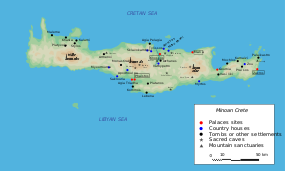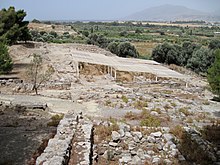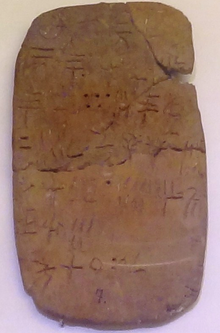Hagia Triada
 Map of Minoan Crete | |
| Location | Faistos, Heraklion, Crete, Greece |
|---|---|
| Region | Messara Plain |
| Coordinates | 35°03′32″N 24°47′33″E / 35.05889°N 24.79250°E |
| Type | Minoan town and "palace" |
| History | |
| Cultures | Minoan |
| Site notes | |
| Excavation dates | 1902-1914, 1934-1936, 1939, 1950, 1977-present |
| Archaeologists | Federico Halbherr, Luigi Pernier et al.[1] |
| Management | State[2] |
| Public access | Yes |
Hagia Triada (also Haghia Triada, Ayia Triada, Agia Triada, Greek: [aˈʝia triˈaða], 'Holy Trinity') is a Minoan archaeological site in Crete. The site includes the remains of an extensive settlement noted for its monumental NeoPalatial and Final Palatial period buildings especially the large Royal Villa. It is located in the Mesara Plain about three kilometers from the larger Palace of Phaistos, with which it appears to have had close political and economic ties. Excavations at Hagia Triada have provided crucial evidence concerning Minoan everyday life.
Notable finds include the Hagia Triada sarcophagus and the "Harvester Vase". About 150 Linear A tablets were found, the largest cache at any Minoan site.[3] Twenty three roundels (circular lumps of clay sealed on the edge) and a large number of nodules (clay lumps with 3 faces of which two had small inscriptions and one face a seal) were also found.[4] All of the Linear A finds date to the Late Minoan IB period, before the site was destroyed by fire and then rebuilt.[5] After being found on 62 Linear B tablets at Knossos, the name "pa-i-to" has been proposed for the ancient name of the nearby site of Phaistos.
The ancient name of Hagia Triada is not yet known though at one point "da-wo" was proposed as well as Scheria from the writing of Homer.[6]
History[edit]
| Timespan | Period | |
|---|---|---|
| 3100–2650 BC | EM I | Prepalatial |
| 2650–2200 BC | EM II | |
| 2200–2100 BC | EM III | |
| 2100–1925 BC | MM IA | |
| 1925–1875 BC | MM IB | Protopalatial |
| 1875–1750 BC | MM II | |
| 1750–1700 BC | MM III | Neopalatial |
| 1700–1625 BC | LM IA | |
| 1625–1470 BC | LM IB | |
| 1470–1420 BC | LM II | Postpalatial |
| 1420–1330 BC | LM IIIA | |
| 1330–1200 BC | LM IIIB | |
| 1200–1075 BC | LM IIIC | |
The site was founded in the Early Minoan I (EM I) period. By the Middle Minoan IA (MM IA) period it is known to have had a cemetery with a large circular "tholos" tomb.[7] The site grew rapidly during the MM IB to MM IIB period.[8][9] With the Protopolatial period (c. 1925 BC) an extensive building program began which continued through the NeoPalatial period. Toward the end of the LM IB period (c. 1625–1470 BC) the site was destroyed by fire. It has been suggested that this destruction resulted from a series of large earthquakes.[10] After that destruction monumental rebuilding occurred on a large scale.[11] By sometime in the Late Minoan III (LM III) period the site came under Mycenae control.[12]
It remained inhabited until the 2nd century BC. Later, a Roman villa was built at the site. Nearby are two chapels: Hagia Triada in the deserted village and Hagios Georgios, built during the Venetian period.[13]
Archaeology[edit]

Hagia Triada is in south central Crete, 30–40 meters above sea level. It lies four kilometers west of Phaistos, which is situated at the western end of the Mesara Plain. The site was not a Minoan palace but an upscale town with some kind of local administration center.[5]
The site was first identified in June 1900 by Luigi Pernier who was excavating at Phaistos at that time. While work proceeded at nearby Phaistos, Hagia Triada was excavated from 1902 to 1908 by a group from the Italian Scuola Archeologica Italiana di Atene, directed by Federico Halbherr and Luigi Pernier.[14][15][16] The site includes a town and a miniature "palace", an ancient drainage system servicing both, and Early Minoan tholos tombs. The settlement was in use, in various forms, from Early Minoan I until the site's destruction by fire in Late Minoan IB.
Excavation resumed between 1910 and 1914, with the addition of Gaetano De Sanctis though the work from this effort is largely unpublished.[17] In 1938 and 1959 Luisa Banti carried out limited excavation at the site.[18] From 1970 until 1976 the site was excavated by Doro Levi and Clelia Laviosa. All of these excavations remain thinly published.[19]
From 1977 to 2012 a team from the Italian Archaeological School at Athens led by Vincenzo La Rosa excavated at the site.[20][21][22][23][24] Publication of this excavation, which focused on the ProtoPalatial levels, is in progress.[25]
Hagia Triada sarcophagus[edit]

In 1903 archaeologists unearthed the Hagia Triada sarcophagus painted with illuminating scenes of funerary rituals.[26][27] It was found in a 3.8 meter by 4.2 meter tomb (Tomb 4) dated to the LM III period and contained two skulls.[28] The tomb is also known as the Tomb of the Painted Sarcophagus and contained a 2nd, clay, sarcophagus (Larnax) and a stone and clay cup, two bronze razors, a clay figurine, and two seals. It has been suggested that a number of grave goods found in the nearby Tomba degli Ori originally resided in this tomb.[29] In 1956 a complete cleaning and restoration of the sarcophagus was completed.[30] It is the only limestone sarcophagus of its era discovered to date and the only sarcophagus with a series of narrative scenes of Minoan funerary ritual. The sarcophagus has fresco painting on all four sides. On the short sides there is a scene of goats (earlier identified as horses or griffin) drawing a chariot, led by a female figure.[31]
In the center of one of the long sides of the sarcophagus is the scene of a bull lying on a table which has two goats squatting underneath. A man, playing an aulos flute and wearing a phorbeia faces the table and is followed in procession by four women.[32]

The second long side, generally called the North or Front (because it faced the door of the tomb), is divided into four scenes. In one a woman who is wearing a crown is carrying two vessels. By her side, a man dressed in a long robe is playing a seven-stringed lyre (Phorminx).[33] This is the earliest known picture of the classical-Greek lyre. In front of them, another woman is emptying the contents of a vessel.[34] On the left, three men holding animals and a boat are approaching a male figure without limbs.[35]
Harvester Vase[edit]
An agrarian procession is depicted on the black steatite "Harvester Vase" which was found in Hagia Triada along with the Chieftain Cup. The lower portion was not preserved. The date of the vase is in some dispute. The range of Middle Minoan III to Late Minoan I had been proposed.[36] An alternative proposal is to the last phase of the neopalatial period (Late Minoan II). Men are walking in twos with rods on their shoulders. The leader is dressed in a priestly robe with a fringe and is carrying a stick. A group of musicians accompany with song, and one of them holds a sistrum.[37][38][39][40] Other interpretations of the procession have been proposed.[41] The Chieftain Cup depicts five males, three with "hides" and two facing each other. One of the later is holding a sword.[42]

See also[edit]
References[edit]
- ^ including Gaetano De Sanctis, Luisa Banti, Doro Levi, Clelia Laviosa, Vincenzo La Rosa
- ^ 23rd Ephorate of Prehistoric and Classical Antiquitites
- ^ [1] Salgarella, Ester, "Drawing lines: The palaeography of Linear A and Linear B", Kadmos, vol. 58, no. 1–2, pp. 61–92, 2019 doi:10.1515/kadmos-2019-0004
- ^ Massimo Perna, "The Roundels of Haghia Triada", Kadmos, 33, pp. 93-141 1994
- ^ a b [2]Tomas, Helena, "The Administration of Haghia Triada", Opvscvla archaeologica 25.1, pp. 39-57, 2001
- ^ Privitera, Santo, "Looking for a Home in a Houseless Town: Exploring Domestic Architecture in Final Palatial Ayia Triada", Hesperia Supplements, vol. 44, pp. 263–72, 2011
- ^ [3]Caloi, I., "The Mesara tholos tomb cemeteries in the Protopalatial period. Comparing the funerary complexes of Kamilari and Ayia Triada", CRETA ANTICA 17, pp. 59-72, 2018
- ^ Girella, Luca, "Evidence for Middle Minoan III occupation at Ayia Triada", British School at Athens Studies, pp. 123-135, 2013
- ^ Carinci F., "Haghia Triada nel periodo Medio Minoico", Creta Antica 4, pp. 97-143, 2003
- ^ Monaco, Carmelo, and Luigi Tortorici, "Effects of Earthquakes on the Minoan 'Royal Villa' at Haghia Triada (Crete)", Creta antica 4, pp. 403-417, 2003
- ^ Halbherr F., Stefani E., Banti L., "Haghia Triada nel periodo tardo palaziale", ASAtene LV, 13-296, 1977
- ^ Privitera, Santo, "Haghia Triada III", The Late Minoan III Buildings in the Villaggio (Monografie della Scuola Archeologica di Atene e delle Missioni Italiane in Oriente 23), Athens: National and Kapodistrian University of Athens and Italian Archaeological School at Athens, 2015
- ^ La Rosa, Vincenzo (2012). "Ayia Triada". In Cline, Eric (ed.). The Oxford Handbook of the Bronze Age Aegean. Oxford University Press. pp. 495–508. doi:10.1093/oxfordhb/9780199873609.013.0037. ISBN 978-0199873609.
- ^ Federico Halbherr, "Lavori eseguiti dalla missione archeologica italiana ad Haghia Triada e nella necropoli di Phaestos dal 15 maggio al 12 giugno 1902", Roma : Tipografia della Reale Accademia dei Lincei, 1902
- ^ Federico Halbherr, "Rapporto alla presidenza del R. Istituto lombardo di scienze e lettere sugli scavi eseguiti dalla missione archeologica ad Haghia Triada ed a Festo nell'anno 1904", Milano : Ulrico Hoepli edit, 1905
- ^ Federico Halbherr & Luigi Savignoni, "Resti dell'eta micena scoperti ad Haghia Triada presso Phaestos : rapporto delle ricerche del 1902", Roma : Tipografia della Reale Accademia dei Lincei, 1903
- ^ Levi Della Vida G., "Scavi della Missione Italiana in Creta", Ausonia 4, pp. 37-38, 1910
- ^ Banti l., "I culti minoici e greci di Haghia Triada", ASAtene 19, pp. 9-74, 1941-43
- ^ La Rosa V., "Haghia Triada: vicende e temi di uno scavo di lungo corso", Creta Antica 4, pp. 11-68, 2003
- ^ La Rosa V., "La ripresa dei lavori ad Haghia Triada: relazione preliminare sui saggi del 1977", ASAtene LV, pp. 297-342, 1977
- ^ La Rosa V., "Haghia Triada II: relazione preliminare sui saggi del 1978 e 1979", ASAtene LVII-LVIII, pp. 49-164, 1979-80
- ^ La Rosa V., "Le nuove indagini ad Haghia Triada", in 5th Diethnes Kritologhiko Synedrio, Ag. Nikolaos, Heraklio, pp. 190-198, 1985
- ^ La Rosa V., "Le campagne del 1986-91 e la conclusione del primo ciclo dei lavori ad Haghia Triada", in 7th Diethnes Kritologhiko Synedrio, Rethymno 1991, Rethymno, pp. 523-542, 1995
- ^ La Rosa, Vincenzo, "La conclusione dei lavori ad Haghia Triada. Le campagne 2010-2012", Creta Antica 15, pp. 129-242, 2015
- ^ Shelby White and Leon Levy Program for Archaeological Publications - "Hagia Triada IV. The Protopalatial Levels (Excavations 1977-2012)"
- ^ Nauert, Jean Porter, "The Hagia Triada Sarcophagus: An Iconographical Study" Antike Kunst 8.H. 2, pp. 91-98, 1965
- ^ Crete: The Archaeological Site of Agia Triada
- ^ Burke, Brendan, "Materialization of Mycenaean Ideology and the Ayia Triada Sarcophagus", American Journal of Archaeology, vol. 109, no. 3, pp. 403–22, 2005
- ^ Girella, Luca. "Middle Minoan III—Late Minoan IIIB Tombs and Funerary Practices in South-Central Crete", Death in Late Bronze Age Greece: Variations on a Theme, pp. 248-281, 2010
- ^ Levi, Doro, "The Sarcophagus of Hagia Triada Restored", Archaeology, vol. 9, no. 3, pp. 192–99, 1956
- ^ Small, Terry, "A Goat-Chariot on the Hagia Triada Sarcophagus", American Journal of Archaeology 76.3, pp. 327-327, 1972
- ^ [4]Kubatzki, Jana. "Processions and Pilgrimage in Ancient Greece: Some Iconographical Considerations", in Ute Luig (ed.) | Approaching the Sacred. Pilgrimage in Historical and Intercultural Perspective | Berlin Studies of the Ancient World 49, pp. 129-157, 2018
- ^ Long, C., "The Ayia Triadha Sarcophagus", Studies in Mediterranean Archaeology 41. Göteborg: P. Åström’s Förlag, 1974
- ^ J.A.Sakellarakis, "Herakleion Museum. Illustrated guide to the Museum" pp. 113,114. Ekdotike Athinon. Athens 1987
- ^ J.A.Sakellarakis, "Herakleion Museum. Illustrated guide to the Museum" p. 114. Ekdotike Athinon. Athens 1987
- ^ Franković, Filip, "A View to a Kilt – The Late Bronze Age Aegean Costume in the Context of Social and Cultural Changes", Praehistorische Zeitschrift, 2023
- ^ Forsdyke, John, "The 'Harvester' Vase of Hagia Triada", Journal of the Warburg and Courtauld Institutes 17.1-2, pp. 1-9, 1954
- ^ Knapp, A. Bernard, "Sound of Silence: Music and Musical Practice in Late Bronze–Iron Age Cyprus", Strings and Threads: A Celebration of the Work of Anne Draffkorn Kilmer, edited by Wolfgang Heimpel and Gabriella Szabo, University Park, USA: Penn State University Press, pp. 121-132, 2011
- ^ J.A.Sakellarakis, "Herakleion Museum. Illustrated guide to the Museum" p. 64. Ekdotike Athinon. Athens 1987
- ^ Anderson, Warren D., "From the Beginnings to the Dark Age", Music and Musicians in Ancient Greece, Ithaca, NY: Cornell University Press, pp. 1-26, 1997
- ^ MacGillivray, J. A. "Reaper’s Rout or Mariner’s March? Reconsidering the ‘Harvester’ Vase from Ayia Triada" Processions: Studies of Bronze Age Ritual and Ceremony presented to Robert B. Koehl, pp. 81-90, 2023
- ^ Evangelos Kyriakidis, "A Sword Type on the Chieftain's Cup (HM 341)", Kadmos, vol. 39, no. 1-2, pp. 79-82, 2000
Further reading[edit]
- Baldacci, Giorgia, "Pottery and ritual activity at Protopalatial Hagia Triada: a foundation deposit and a set of broken rhyta from the Sacello", Creta Antica 15, pp. 47-62, 2015
- [5]Martino, Paula L., "Egyptian ideas, Minoan rituals: evidence of the interconnections between Crete and Egypt in the Bronze Age on the Hagia Triada sarcophagus", Journal of Ancient Egyptian Interconnections 4.1, pp. 31-50, 2012
- [6]Monzani, Juliana Caldeira, "Spatial analysis in archaeology. A study of case: Hagia Triada, Crete", Revista do Museu de Arqueologia e Etnologia. Suplemento, pp. 143-148, 2009
- Privitera, Santo, "The LM III frescoes from the villaggio at Hagia Triada: New observations on context and chronology", Creta antica 9, pp. 111-137, 2008
- Privitera, Santo, "The tomb, the house, and the double axes: Late Minoan IIIA2 Hagia Triada as a ritual and ‘mythical’place", AEGAEUM 39, pp. 149-156, 2016
- Weingarten, Judith, "Seal-use at LM IΒ Ayia Triada: a Minoan elite in action I. Administrative considerations", Kadmos 26.1, pp. 1-43, 1987
